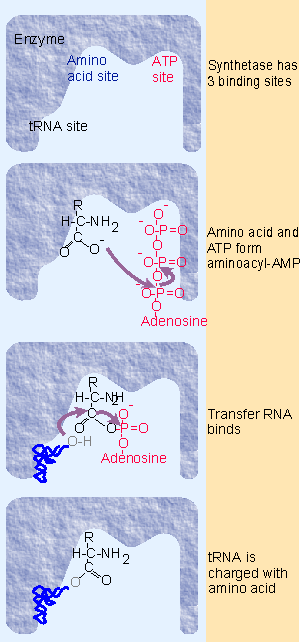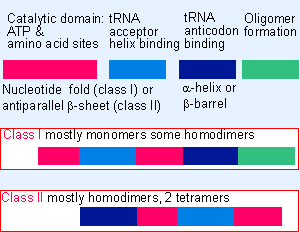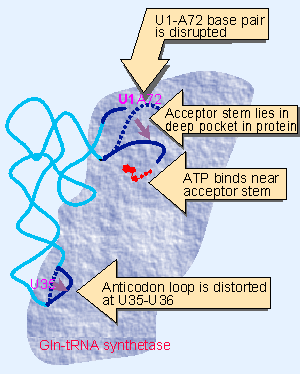5. tRNAs are charged with amino acids by synthetases
7.5 tRNAs are charged with amino acids by synthetases |
| Key terms defined in this section |
| Cognate tRNAs are those recognized by a particular aminoacyl-tRNA synthetase. Isoaccepting tRNA s represent the same amino acid. |
It is necessary for tRNAs to have certain characteristics in common, yet be distinguished by others. The crucial feature that confers this capacity is the ability of tRNA to fold into a specific tertiary structure. Changes in the details of this structure, such as the angle of the two arms of the "L" or the protrusion of individual bases, may distinguish the individual tRNAs.
All tRNAs can fit in the P and A sites of the ribosome, where at one end they are associated with mRNA via codon-anticodon pairing, while at the other end the polypeptide is being transferred. Similarly, all tRNAs (except the initiator) share the ability to be recognized by the translation factors (EF-Tu or eEF-1) for binding to the ribosome. The initiator tRNA is recognized instead by IF-2 or eIF2. So the tRNA set must possess common features for interaction with elongation factors, but the initiator tRNA can be distinguished.
 |
Figure 7.10 An aminoacyl-tRNA synthetase charges tRNA with an amino acid. |
Amino acids enter the protein synthesis pathway through the aminoacyl-tRNA synthetases, which provide the interface for connection with nucleic acid. All synthetases function by the two-step mechanism depicted in Figure 7.10:
- First, the amino acid reacts with ATP to form aminoacyl~adenylate, releasing pyrophosphate. Energy for the reaction is provided by cleaving the high energy bond of the ATP.
- Then the activated amino acid is transferred to the tRNA, releasing AMP.
The synthetases sort the tRNAs and amino acids into corresponding sets, each synthetase recognizing a single amino acid and all the tRNAs that should be charged with it. Usually, each amino acid is represented by more than one tRNA. (There may be many such tRNAs. In addition to the several tRNAs that are needed to respond to synonym codons, sometimes there are multiple species of tRNA reacting with the same codon.) Multiple tRNAs representing the same amino acid are called isoaccepting tRNAs; because they are all recognized by the same synthetase, they are also described as its cognate tRNAs.
In spite of their common function, synthetases are a rather diverse group of proteins. The individual subunits vary from 40 V110 kD, and the enzymes may be monomeric, dimeric, or tetrameric. Homologies between them are rare. Of course, the active site that recognizes tRNA comprises a rather small part of the molecule. It is interesting to compare the active sites of different synthetases.
 |
Figure 7.11 An aminoacyl-tRNA synthetase contains three or four regions with different functions. (Only multimeric synthetases possess an oligomerization domain.) |
Synthetases have been divided into two general groups, each containing 10 enzymes, on the basis of the structure of the domain that contains the active site. A general type of organization that applies to both groups is represented in Figure 7.11. The catalytic domain includes the binding sites for ATP and amino acid. It can be recognized as a large region that is interrupted by an insertion of the domain that binds the acceptor helix of the tRNA. This places the terminus of the tRNA in proximity to the catalytic site. A separate domain binds the anticodon region of tRNA. Those synthetases that are multimeric also possess an oligomerization domain (for review see 34).
Class I synthetases have an N-terminal catalytic domain that is identified by the presence of two short, partly conserved sequences of amino acids, sometimes called "signature sequences." The catalytic domain takes the form of a motif called a nucleotide-binding fold (which is also found in other classes of enzymes that bind nucleotides). The nucleotide fold consists of alternating parallel β-strands and α-helices; the signature sequence forms part of the ATP-binding site. The insertion that contacts the acceptor helix of tRNA differs widely between different class I enzymes. The C-terminal domains of the class I synthetases, which include the tRNA anticodon-binding domain and any oligomerization domain, also are quite different from one another.
Class II enzymes share three rather general similarities of sequence in their catalytic domains. The active site contains a large antiparallel β-sheet surrounded by α-helices. Again, the acceptor helix-binding domain that interrupts the catalytic domain has a structure that depends on the individual enzyme. The anticodon-binding domain tends to be N-terminal. The location of any oligomerization domain is widely variable.
The lack of any apparent relationship between the two groups of synthetases is a puzzle. Perhaps they evolved independently of one another. This makes it seem possible even that an early form of life could have existed with proteins that were made up of just the 10 amino acids coded by one type or the other.
 |
Figure 7.12 Crystal structures show that class I and class II aminoacyl-tRNA synthetases bind the opposite faces of their tRNA substrates. The tRNA is shown in red, and the protein in blue. Photographs kindly provided by Dino Moras. Multiple figure |
A general model for synthetase PtRNA binding suggests that the protein binds the tRNA along the "side" of the L-shaped molecule. The same general principle applies for all synthetase PtRNA binding: the tRNA is bound principally at its two extremities, and most of the tRNA sequence is not involved in recognition by a synthetase. However, the detailed nature of the interaction is different between class I and class II enzymes, as can be seen from the models of Figure 7.12, which are based on crystal structures. The two types of enzyme approach the tRNA from opposite sides, with the result that the tRNA-protein models look almost like mirror images of one another.
 |
Figure 7.13 A class I tRNA synthetase contacts tRNA at the minor groove of the acceptor stem and at the anticodon. |
A class I enzyme (Gln-tRNA synthetase) approaches the D-loop side of the tRNA. It recognizes the minor groove of the acceptor stem at one end of the binding site, and interacts with the anticodon loop at the other end. Figure 7.13 is a diagrammatic representation of the crystal structure of the tRNAGln Psynthetase complex. A revealing feature of the structure is that contacts with the enzyme change the structure of the tRNA at two important points. These can be seen by comparing the dotted and solid lines in the anticodon loop and acceptor stem:
- Bases U35 and U36 in the anticodon loop are pulled farther out of the tRNA into the protein.
- The end of the acceptor stem is seriously distorted, with the result that base pairing between U1 and A72 is disrupted. The single-stranded end of the stem pokes into a deep pocket in the synthetase protein, which also contains the binding site for ATP.
This structure explains why changes in U35, G73, or the U1-A72 base pair affect the recognition of the tRNA by its synthetase. At all of these positions, hydrogen bonding occurs between the protein and tRNA (447).
 |
Figure 7.14 A class II aminoacyl-tRNA synthetase contacts tRNA at the major groove of the acceptor helix and at the anticodon loop. |
A class II enzyme (Asp-tRNA synthetase) approaches the tRNA from the other side, and recognizes the variable loop, and the major groove of the acceptor stem, as drawn in Figure 7.14. The acceptor stem remains in its regular helical conformation. ATP is probably bound near to the terminal adenine. At the other end of the binding site, there is a tight contact with the anticodon loop, which has a change in conformation that allows the anticodon to be in close contact with the protein (448).
Many attempts to deduce similarities in sequence between cognate tRNAs, or to induce chemical alterations that affect their charging, have shown that the basis for recognition is different for different tRNAs, and does not necessarily lie in some feature of primary or secondary structure alone. We know from the crystal structure that the acceptor stem and the anticodon stem make tight contacts with the synthetase, and mutations that alter recognition of a tRNA are found in these two regions. (The anticodon itself is not necessarily recognized as such; for example, the "suppressor" mutations discussed later in this chapter change a base in the anticodon, and therefore the codons to which a tRNA responds, without altering its charging with amino acids.)
A group of isoaccepting tRNAs must be charged only by the single aminoacyl-tRNA synthetase specific for their amino acid. So isoaccepting tRNAs must share some common feature(s) enabling the enzyme to distinguish them from the other tRNAs. The entire complement of tRNAs is divided into 20 isoaccepting groups; each group is able to identify itself to its particular synthetase.
tRNAs are identified by their synthetases by contacts that recognize a small number of bases, typically from 1 V5. Three types of feature commonly are used:
- Usually (but not always), at least one base of the anticodon is recognized. Sometimes all the positions of the anticodon are important.
- Often one of the last three base pairs in the acceptor stem is recognized. An extreme case is represented by alanine tRNA, which is identified by a single unique base pair in the acceptor stem.
- The so-called discriminator base, which lies between the acceptor stem and the CCA terminus, is always invariant among isoacceptor tRNAs.
No one of these features constitutes a unique means of distinguishing 20 sets of tRNAs, or provides sufficient specificity, so it appears that recognition of tRNAs is idiosyncratic, each following its own rules.
Several synthetases can specifically charge a "minihelix" consisting only of the acceptor and TΨ C arms (equivalent to one arm of the L-shaped molecule) with the correct amino acid. The efficiency of aminoacylation of these substrates is much higher for the class II enzymes. For these tRNAs, specificity depends exclusively upon the acceptor stem. However, it is clear that there are significant variations between tRNAs, and in some cases the anticodon region is important. Mutations in the anticodon can affect recognition by the class II Phe-tRNA synthetase. Multiple features may be involved; minihelices from the tRNAVal and tRNAMet (where we know that the anticodon is important in vivo) can react specifically with their class I synthetases.
So recognition depends on an interaction between a few points of contact in the tRNA, concentrated at the extremities, and a few amino acids constituting the active site in the protein. The relative importance of the roles played by the acceptor stem and anticodon is different for each tRNA Psynthetase interaction (for review see 35).
| Reviews | |
| 34: | Schimmel, P. (1987). Aminoacyl-tRNA synthetases: general scheme of structure-function relationships on the polypeptides and recognition of tRNAs. Ann. Rev. Biochem 56, 125-158. |
| 35: | Schimmel, P. (1989). Parameters for the molecular recognition of tRNAs. Biochemistry 28, 2747-2759. |
| Research | |
| 447: | Rould, M. A. et al. (1989). Structure of E. coli glutaminyl-tRNA synthetase complexed with tRNAGln and ATP at 28Å resolution. Science 246, 1135-1142. |
| 448: | Ruff, M. et al. (1991). Class II aminoacyl tRNA synthetases: crystal structure of yeast aspartyl-tRNA synthetase complexes with tRNAAsp. Science 252, 1682-1689. |